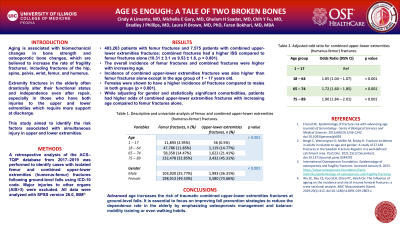Trauma
Category: Quickshot Oral Session 18
Quickshot Oral : Quickshot Oral Session 18
AGE IS ENOUGH: A TALE OF TWO BROKEN BONES
Monday, February 13, 2023
7:00am - 8:00am East Coast USA Time

- CL
Cindy Limanto, MD
United States
- FB
Faran Bokhari, MD
United States
Presenter(s)
Principal Contact(s)
Objectives: Elderly patients are at risk for traumatic femur fractures. The aim of this study was to determine the factors associated with the risk of combined femur and humerus fractures.
Methods: We retrospectively analyzed the (2017-2019) ACS-TQIP database to identify patients with femur and femur-humerus fractures using the ICD-10 code. Patients with major injuries to other organs (AIS >3) were excluded. Univariate analysis was performed for age (1-17, 18-64, 65-74, 75+), gender, race, GCS, ISS, vital signs, and comorbidities for a primary outcome of combined femur-humerus fractures. Multivariate logistic regression was performed adjusting for gender, steroid use, dementia or mental disorder, anticoagulation, decreased functional status, cirrhosis, CHF, DM, HTN, and COPD. All statistical analyses were performed using SPSS with a 95% confidence interval.
Results: A total of 403,263 patients with femur fractures and 7,575 patients with combined femur-humerus fractures were identified. Patients had higher odds of combined femur-humerus fractures with increased age: 18-64 years-old (OR 1.05, 95% CI [1.04, 1.07], p < 0.001); 65-74 years-old (OR 1.72, 95% CI [1.60, 1.85], p < 0.001), and 75-89 years-old (OR 1.90, 95% CI [1.84, 2.01], p< 0.001).
Conclusion: Advanced age has increased risk of combined humerus-femur fractures. Clinicians should anticipate a higher burden of injury with falls in these patients. Prevention strategies should target these individuals.
Methods: We retrospectively analyzed the (2017-2019) ACS-TQIP database to identify patients with femur and femur-humerus fractures using the ICD-10 code. Patients with major injuries to other organs (AIS >3) were excluded. Univariate analysis was performed for age (1-17, 18-64, 65-74, 75+), gender, race, GCS, ISS, vital signs, and comorbidities for a primary outcome of combined femur-humerus fractures. Multivariate logistic regression was performed adjusting for gender, steroid use, dementia or mental disorder, anticoagulation, decreased functional status, cirrhosis, CHF, DM, HTN, and COPD. All statistical analyses were performed using SPSS with a 95% confidence interval.
Results: A total of 403,263 patients with femur fractures and 7,575 patients with combined femur-humerus fractures were identified. Patients had higher odds of combined femur-humerus fractures with increased age: 18-64 years-old (OR 1.05, 95% CI [1.04, 1.07], p < 0.001); 65-74 years-old (OR 1.72, 95% CI [1.60, 1.85], p < 0.001), and 75-89 years-old (OR 1.90, 95% CI [1.84, 2.01], p< 0.001).
Conclusion: Advanced age has increased risk of combined humerus-femur fractures. Clinicians should anticipate a higher burden of injury with falls in these patients. Prevention strategies should target these individuals.

